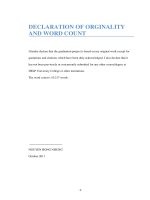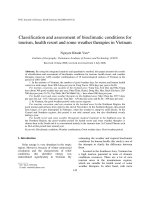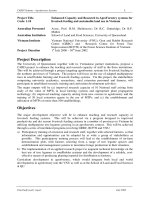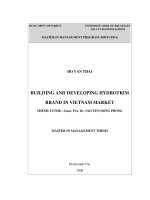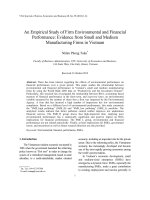Building and developing hydrotrim brand in Vietnam market
Bạn đang xem bản rút gọn của tài liệu. Xem và tải ngay bản đầy đủ của tài liệu tại đây (4.31 MB, 135 trang )
HCMC OPEN UNIVERSITY UNIVERSITEÙ LIBRE DE BRUXELLES
SOLVAY BUSINESS SCHOOL
MASTER IN MANAGEMENT PROGRAM (MMVCFB 6)
HO VAN THAI
BUILDING AND DEVELOPING HYDROTRIM
BRAND IN VIETNAM MARKET
THESIS TUTOR : Assoc. Pro. Dr. NGUYEN DONG PHONG
MASTER IN MANAGEMENT THESIS
Hochiminh City
2006
WARRANT STATEMENT
This is my original work. All data and results stated in the
thesis are completely true.
Ho Van Thai
ACKNOWLEDGEMENTS
I wish to express my deep gratitude to Professors, Universiteù Libre de Bruxelles,
Solvay Business School and Hochiminh City Open University for providing
knowledge and giving valuable experience during my study.
I would like to give my special thanks to my Tutor, Associate Professor Doctor
Nguyen Dong Phong, for his valuable guidance, advice and encouragement
throughout my research study.
Deep appreciation and thanks are also extended to my colleagues, classmates,
Mega Lifesciences Company and my family for their support and
encouragement throughout the program.
Ho Chi Minh City, 20 November 2006
Ho Van Thai
TABLE OF CONTENTS
Acknowledgements
Comments
List of figures
List of tables
Introduction …………………………………………………………………………………………………………………………… 1
1. Problem statement ……………………………………………………………………………………………… 1
2. Objectives of research study ……………………………………………………………………………. 2
3. Scope and limitation of research study ………………………………………………………… 2
4. Study method ………………………………………………………………………………………………………… 3
5. Structure of the study ………………………………………………………………………………………… 4
Chapter 1: Literature review ………………………………………………………………………………………… 5
1.1. Definition of brand …………………………………………………………………………………………… 5
1.1.1. What is a brand? …………………………………………………………………………………………………… 5
1.1.2. Brands versus products ………………………………………………………………………………………… 5
1.2. Brand building and developing ……………………………………………………………………… 6
1.2.1. Brand orientation model …………………………………………………………………………………… 7
1.2.2. Corporate branding ………………………………………………………………………………………………. 9
1.2.3. Building Brand Value through Customer Service …………………………………… 13
1.2.4. The role of public relations in branding …………………………………………………… 13
1.3. Branding in pharmaceutical industry …………………………………………………………… 15
1.3.1. Pharmaceutical brands ………………………………………………………………………………………. 15
1.3.2. The Brand Value Pyramid – Functional vs. Emotional Benefits ……… 17
1.3.3. Laying the Foundations …………………………………………………………………………………… 18
Summary of chapter 1 ……………………………………………………………………………………………………. 20
Chapter 2: Introduction to Mega Lifesciences, Vietnam pharmaceutical market
and reducing weight product market ………………………………………………………………. 21
2.1. Overview of Mega Lifesciences Company Limited (Mega We Care) 21
2.1.1. Mega Lifesciences International ………………………………………………………………. 21
2.1.2. Mega Lifesciences Vietnam ………………………………………………………………………. 25
2.1.2.1. History …………………………………………………………………………………………………………… 25
2.1.2.2. Operation………………………………………………………………………………………………………. 26
2.1.2.3. Organization ………………………………………………………………………………………………. 26
2.1.2.4. Medicap’s philosophy, objectives and strategy………………………………… 29
2.1.2.5. Medicap’s products ……………………………………………………………………………………… 30
2.1.2.6. Medicap’s sales performance . ………………………………………………………………… 31
2.2. Pharmaceutical Market in Vietnam ……………………………………………………………… 33
2.2.1. Overview of pharmaceutical market in Vietnam …………………………………. 33
2.2.2. OTC pharmaceutical market in Vietnam …………………………………………………. 34
2.3. Reducing weight product market …………………………………………………………………… 34
2.3.1. Overweight and obesity concepts ……………………………………………………………… 34
2.3.1.1. What are overweight and obesity? …………………………………………………………… 34
2.3.1.2. Facts about overweight and obesity………………………………………………………… 36
2.3.1.3. Overweight and obesity in Vietnam …………………………………………………………. 37
2.3.2. Survey on reducing weight product market in Vietnam ……………………… 38
2.3.3. Analysis of Hydrotrim competitors ……………………………………………………………… 41
2.3.3.1. Classification by price and scientific proof …………………………………………. 41
2.3.3.2. Strenghts and weaknesses of Hydrotrim competitors …………………… 42
2.3.4. Opportunities and threats of Hydrotrim ………………………………………………… 44
2.3.4.1. Opportunities ………………………………………………………………………………………………… 44
2.3.4.2. Threats ……………………………………………………………………………………………………………… 45
Summary of chapter 2 …………………………………………………………………………………………………. 46
Chapter 3: Building and developing Hydrotrim brand in Vietnam for the last
period……………………………………………………………………………………………………………………………………. 47
3.1. Targeting and positioning Hydrotrim …………………………………………………………… 47
3.1.1. Hydrotrim consumer profile…………………………………………………………………………… 47
3.1.2. Customers ……………………………………………………………………………………………………………. 48
3.1.3. Positioning …………………………………………………………………………………………………………… 48
3.2. Hydrotrim identity …………………………………………………………………………………………………. 49
3.2.1. Hydrotrim brand as a product ……………………………………………………………………… 49
3.2.2. Hydrotrim price …………………………………………………………………………………………………… 50
3.2.3. Hydrotrim image………………………………………………………………………………………………… 50
3.2.3.1. Hydrotrim name, color and symbol…………………………………………………………… 50
3.2.2.3. Communication ……………………………………………………………………………………………… 52
3.3. Integrated marketing programs to build and develop Hydrotrim brand in
Vietnam …………………………………………………………………………………………………………………………………. 52
3.3.1. Marketing objectives of Hydrotrim for the first 12 months ………………… 52
3.3.2. Hydrotrim trial campaign to build the credibility ………………………………… 53
3.3.2.1. The trial research cooperated with Traditional Medicine Institute 53
3.3.3.2. Two trial researches by Mega Lifesciences itself ………………………… 55
3.3.3. Hydrotrim launching campaign ……………………………………………………………………… 56
3.3.3.1. Pharmacy meeting in Hochiminh city and Hanoi ……………………………………. 56
3.3.3.2. Television talk show …………………………………………………………………………………………. 58
3.3.3.3. Press articles ……………………………………………………………………………………………………… 59
3.3.3.4. Tele-consulting program……………………………………………………………………………… 60
3.3.3.5. Consumer promotion ……………………………………………………………………………………. 62
3.3.3.6. Trade promotion ………………………………………………………………………………………….… 63
3.3.3.7. P.O.S. display …………………………………………………………………………………………………. 63
3.3.3.8. Medicap Sales Force……………………………………………………………………………………. 65
3.3.4. Hydrotrim post-launching campaign…………………………………………………………. 65
3.3.4.1. Television programs ……………………………………………………………………………………… 66
3.3.4.2. Press articles …………………………………………………………………………………………………… 66
3.3.4.3. Trade promotion …………………………………………………………………………………………… 66
3.3.4.4. Promoter Girl at pharmacies ………………………………………………………………………. 67
3.3.4.5. Promoter Girl at supermarkets ……………………………………………………………………. 67
3.4. Evaluation of building and developing Hydrotrim brand …………………………… 68
3.4.1. Sales performance ……………………………………………………………………………………………… 68
3.4.1.1. Sales of Hydrotrim from June 2005 (launching month) to June 2006 68
3.4.1.2. Sales evolution from June 2005 to June 2006 …………………………………………. 69
3.4.1.3. Sales vs. target for the first 12 months ……………………………………………………… 70
3.4.1.4. Ranking of Hydrotrim …………………………………………………………………………………… 70
3.4.2. Availability of Hydrotrim at pharmacies ……………………………………………………. 70
3.4.3. Survey on Hydrotrim brand awareness ………………………………………………………. 72
3.4.3.1. Consumers surveyed and methodology ………………………………………………… 72
3.4.3.2. Results of the survey………………………………………………………………………………………. 72
3.4.4. Survey on consumer perception of Hydrotrim brand ……………………………. 73
3.4.4.1. Objectives of the survey ……………………………………………………………………………. 73
3.4.4.2. Criteria to select consumers ………………………………………………………………………… 74
3.4.4.3. Methodology …………………………………………………………………………………………………… 76
3.4.4.4. Results of the survey ……………………………………………………………………………………… 76
3.4.5. Survey on pharmacy perception of Hydrotrim brand ………………….…………. 83
3.4.5.1. Objectives of the survey ……………………………………………………………………………… 83
3.4.5.2. Criteria to select pharmacies ………………………………………………………………………. 83
3.4.5.3. Results of the survey………………………………………………………………………………………… 84
3.5. SWOT analysis …………………………………………………………………………………………………………. 95
3.5.1. Strengths …………………………………………………………………………………………………………………… 95
3.5.2. Weaknesses ……………………………………………………………………………………………………………… 97
3.5.3. Opportunities ………………………………………………………………………………………………………… 98
3.5.4. Threats ………………………………………………………………………………………………………………………. 99
Summary of chapter 3 ……………………………………………………………………………………………………. 100
Chapter 4: Recommendations for developing Hydrotrim brand in Vietnam
market for the next years ……………………………………………………………………………………………… 101
4.1. Marketing objectives for the years from 2007 to 2010 …………………………… 101
4.2. Marketing programs for the years 2007 to 2010 ………………………………………… 102
4.2.1. TV programs ………………………………………………………………………………………………………… 102
4.2.1.1. TV channels ………………………………………………………………………………………………………… 102
4.2.1.2. Programs and contents …………………………………………………………………………………… 103
4.2.2. Press articles ……………………………………………………………………………………………………………. 103
4.2.2.1. Newspapers and magazines …………………………………………………………………………… 103
4.2.2.2. Contents ………………………………………………………………………………………………………………… 103
4.2.3. P.O.S. materials …………………………………………………………………………………………………… 104
4.2.4. Tele-consulting activity …………………………………………………………………………………… 105
4.2.5. Trade promotion and consumer promotion ………………………………………………… 106
4.2.6. New programs …………………………………………………………………………………………………………. 106
4.2.6.1. TV commercials…………………………………………………………………………………………………… 106
4.2.6.2. Press advertisements ……………………………………………………………………………………… 106
4.2.6.3. P.O.S. display …………………………………………………………………………………………………… 107
4.2.7. Market research ……………………………………………………………………………………………………. 107
4.2.8. Sales Force …………………………………………………………………………………………………………… 108
Summary of chapter 4 …………………………………………………………………………………………………… 109
Conclusions ……………………………………………………………………………………………………………………… 110
Lessons ……………………………………………………………………………………………………………………………… 111
Appendices
References
LIST OF FIGURES
Figure Content Page
1 Brand hexagon 10
2 Elements of corporate branding 11
3 The six conventions of corporate branding 12
4 Brand value pyramid 17
5 Organization chart of Mega Lifesciences Vietnam 27
6 Organization chart of Medicap Vietnam 28
7 Organization chart of consulting of Medicap Vietnam 29
8 Medicap sales performance from 2000 to 2005 31
9 Medicap sales by customer type in 2004 and 2005 32
10 A picture of one target consumer of Hydrotrim 47
11 Hydrotrim box and sachets 51
12 Pharmacy meeting in Hochiminh city 55
13 Talk show “Kien Thuc Tieu Dung” on HTV 7 59
14 Consulting cards sent to Hydrotrim consumers 61
15 Hydrotrim VCD package 62
16 Hydrotrim poster 63
17 Hydrotrim leaflet 64
18 Hydrotrim sales kit 65
19 A Promoter Girl worked at Maximart Cong Hoa, HCMC 68
20 Sales of Hydrotrim from June 2005 to June 2006 69
21 Percentage of means consumers know Hydrotrim from 77
22 Percentage of responses to benefits to consumers 85
Figure Content Page
23 Evaluation of TV programs 86
24 Evaluation of press article activity 86
25 Evaluation of trade promotion activity 87
26 Evaluation of consumer promotion activity 88
27 Evaluation of leaflet at pharmacy activity 88
28 Evaluation of Promoter activity 89
29 Evaluation of tele-consulting activity 90
30 Suggestions for other marketing activities of Hydrotrim 91
31 Top selling reducing weight brands at pharmacies 93
32 Advantages of top selling competitors of Hydrotrim 94
LIST OF TABLES
Table Content Page
1 Estimated market shares of reducing weight brands 40
2 Marketing objectives of Hydrotrim for the first twelve months 52
3 Figures of patients in the trial research 53
4 Sales performance of Hydrotrim from June 2005 to June 2006 69
5 Sales versus target of Hydrotrim for the first 12 months 70
6 Availability of Hydrotrim at pharmacies 71
7 Number of pharmacies selling Hydrotrim 71
8 Top of mind brand awareness of three top reducing weight
brands
73
9 Aided brand awareness 73
10 Consumers partcipated in the survey 75
11 Age of consumers surveyed 76
12 The means consumers know Hydrotrim from 76
13 Consumers observed side-effects of Hydrotrim 77
14 The results of reducing weight of consumers surveyed 78
15 Evaluation of reducing weight result of Hydrotrim 79
16 Reasons of dissatisfaction with the reducing weight result 79
17 Consumers like tele-consulting or not 80
18 Attitude to receive calls 80
19 Communication skill of tele-consulting staff 80
20 Answers to consumers’ questions 81
21 Time to receive calls 81
Table Content Page
22 Suggestions for improvement of tele-consulting activity 81
23 Evaluation of Hydrotrim gift to consumers 82
24 Suggestion for improvement of Hydrotrim gift to consumers 82
25 Number of pharmacies surveyed allocated by city 84
26 Benefits to consumers 84
27 Evaluation of TV programs 85
28 Evaluation of press article activity 86
29 Evaluation of trade promotion activity 87
30 Evaluation of consumer promotion activity 87
31 Evaluation of leaflet at pharmacy activity 88
32 Evaluation of Promoter activity 89
33 Evaluation of tele-consulting activity 89
34 Summary of evaluation of all Hydrotrim marketing activities 90
35 Suggestions of pharmacies for other marketing activities 91
36 Top selling reducing weight brands at pharmacies 93
37 Advantages of top selling competitors of Hydrotrim 94
38 Marketing objectives of Hydrotrim for the years from 2007 to
2010
101
- 1 -
INTRODUCTION
1. PROBLEM STATEMENT
Branding is a hot topic these days. Especially, when Vietnam joins WTO,
Vietnamese businesses will face with opportunities and challenges to exist and
develop and they realize the importance of the issue. However, many local firms
still wonder whether to focus on manufacturing quality products or building and
developing strong brands. On the other side, many other Vietnamese companies
realize the importance of branding but do not know how to build a strong brand.
They are not confident enough to compete with famous brands from foreign
multinational corporations.
Mega Lifesciences is a medium pharmaceutical company from Thailand, an
Asean country. It is one of the fastest growth pharmaceutical companies in
Vietnam (IMS report Quarter II 2006). Working for Mega Lifesciences, I know
that its management board deeply understands the importance of building
product brands together with corporate brand. They are continuously building
their brands to compete with strong brands from The United States and European
countries. According to the management board, Hydrotrim, a reducing weight
brand, is the most successful brand in a sense of sales and profit for the first year
of launching. We know that reducing weight market is a potential market with
too many competitors. Two of them are from two famous multinational
pharmaceutical companies in the world. It means that it is not easy to be in the
top of this category.
- 2 -
The following questions were raised when I prepared for this thesis:
Is Hydrotrim successful in the brand building process?
Why is it successful?
What should Mega Lifesciences do to develop Hydrotrim brand?
What lessons can Vietnamese businesses learn from the case of building and
developing Hydrotrim brand in Vietnam?
To find answers to the above questions encouraged me to make this research
study.
2. OBJECTIVES OF RESEARCH STUDY
The objectives of the research study are described as follows.
First of all, the study will state the importance of brand building and developing
in the survival and development of a product.
Secondly, this research will help us to study the building Hydrotrim brand in
Vietnam for the last year and then to understand the evaluation of consumers and
pharmacies on the brand.
Finally, we will give some recommendations for developing Hydrotrim brand for
the next years.
3. SCOPE AND LIMITATION OF RESEARCH STUDY
This research will concentrate on the building and developing Hydrotrim brand
since the launching in Vietnam market in June 2005.
- 3 -
It will only focus on Hydrotrim of Mega Lifesciences in big cities such as
Hochiminh city, Hanoi, Haiphong, Hue, Danang, Nhatrang, Bienhoa, Mytho,
Cantho, Longxuyen and Camau.
Finally, we will give some recommendations for developing Hydrotrim brand in
Vietnam market for the period from 2007 to 2010.
4. STUDY METHOD
In this research study, we will use two following methods.
Desk research
Information on the Mega Lifesciences company will be got from the company
website (megawecare.com), company reports and from company management.
We will get information on Hydrotrim and competitors from Mega Lifesciences
researches, company reports and IMS Meridian Research reports.
Marketing survey or field research
We intend to implement two marketing surveys. The first one will be interviews
by phone of 100 consumers who fulfill the course of eight weeks of using
Hydrotrim. This survey is to understand consumers’ perception of Hydrotrim.
The second one will be interviews of 280 pharmacies which are selling
Hydrotrim. This research is aimed at knowing pharmacies’ perception of
Hydrotrim.
- 4 -
Primary data will be processed by SPSS software to become secondary data and
they will serve the analysis of consumers and pharmacies’ perception of
Hydrotrim.
5. STRUCTURE OF THE STUDY
Introduction
Chapter 1 Literature Review
Chapter 2 Introduction to Mega Lifesciences, Vietnam pharmaceutical market
and reducing weight market
Chapter 3 Building and developing Hydrotrim brand in Vietnam for the last
period
Chapter 4 Recommendations for developing Hydrotrim brand in Vietnam market
for the years from 2007 to 2010
Conclusions
- 5 -
Chapter 1
Literature Review
1.1. Definition of brand
1.1.1. What is a brand?
1
Branding has been around for centuries as a means to distinguish the goods of
one producer from those of another. In fact, the word “brand” is derived from the
Old Norse word “brandr”, which means “to burn”, as brands were and still are
the means by which owners of livestock , mark their animals to identify them.
According to the American Marketing Association, a brand is a “name, term,
sign, symbol, or design, or a combination of them intended to identify the goods
and services of one seller or group of sellers and to differentiate them from those
of competition.” Thus, the key to creating a brand, according to this definition, is
to choose a name, logo, symbol, package design, or other attribute that identifies
a product and distinguishes it from others. We can call these different
components of a brand, which identify and differentiate it, brand elements.
1.1.2. Brands versus products
1
It is important to contrast a brand and a product. According to Philip Kotler, a
product is anything that can be offered to a market for attention, acquisition, use
or consumption that might satisfy a need or want. Thus, a product may be a
physical good, service, retail store, person, organization, place or idea.
Kotler defines five levels of a product:
1. The core benefit level is the fundamental need or want that consumers
1
Kevin Keller Klane, Strategic brand management.
- 6 -
satisfy by consuming the product or service.
2. The generic product level is a basic version of the product containing only
those attributes or characteristics absolutely necessary for its functioning
but with no distinguishing features. This is basically a stripped-down, “no-
frills” version of the product that adequately performs the product
function.
3. The expected product level is a set of attributes or characteristic that
buyers normally expect and agree to when they purchase a product.
4. The augmented product level includes additional product attributes,
benefits, or related services that distinguish the product from competitors.
5. The potential product level includes all of the augmentations and
transformations that a product might ultimately undergo in the future.
A brand is a product, then, but one that adds other dimensions to differentiate it in
some way from other products designed to satisfy the same need. These
differences may be rational and tangible – related to product performance or the
brand – or more symbolic, emotional and intangible – related to what the brand
represents.
More specifically, what distinguishes a brand from its unbranded commodity
counterpart and gives it equity is the sum total of consumers’ perceptions and
feelings about the product’s attributes and how they perform, about the brand
name and what it stands for, and about the company associated with the brand.
1.2. Brand building and developing
- 7 -
1.2.1. Brand Orientation Model
2
Urde (1999) presents Brand Orientation as a brand building model that focuses
on brands as strategic resources. “Brand Orientation is an approach in which the
processes of the organization revolve around the creation, development, and
protection of brand identity in an ongoing interaction with target customers with
the aim of achieving lasting competitive advantages in the form of brands” (p.
117-118). Brand orientation focuses on developing brands in a more active and
deliberate manner, starting with the brand identity as a strategic platform. It can
be said that as a consequence of this orientation the brand becomes an
“unconditional response to customer needs and wants” (p. 120). This should be,
however, considered carefully given that “what is demanded by customers at any
given moment is not necessarily the same as that which will strengthen the brand
as a strategic resource” (p. 121). Following this reasoning, “the wants and needs
of customers are not ignored, but they are not allowed to unilaterally steer the
development of the brand and determine its identity” (p. 122).
According to the brand orientation model, “the starting point for a process of
brand building is to first create a clear understanding of the internal brand
identity. The brand then becomes a strategic platform that provides the
framework for the satisfaction of customers’ wants and needs” (Urde 1999, p.
129) The point of departure for a brand-oriented company is its brand mission.
Urde’s Brand Hexagon (1999), shown in Figure 1, integrates brand equity and
brand identity with a company’s direction, strategy and identity. The right side of
2
Francisco Guzman, Brand building towards social values: associating to public goods,
www.brandchannel.com.
- 8 -
the model reflects the reference function -product category and product, which
are analyzed rationally-, while the left side of the model reflects the emotional
function -corporate and brand name, which are analyzed emotionally. “A brand
is experienced in its entirety” (p. 126), which means that both emotions and
rational thought are involved. The lower part of the model -mission and vision-
reflects the company’s intentions towards the brand, while the upper part reflects
the way that target consumers interpret the brand. At the center of the model lies
the core process of brand meaning creation, which includes the positioning and
core values.
Figure 1: Brand Hexagon (Source: Urde 1999)
In summary, “in a brand-oriented organization, the objective is -within the
framework of the brand-to create value and meaning. The brand is a strategic
platform for interplay with the target group and thus is not limited to being an
- 9 -
unconditional response to what at any moment is demanded by customers” (Urde
1999, p. 130).
Additionally, in a later article, Urde (2003) mentions that the brand building
process is two-part: internal and external. He defines the internal process as that
used primarily to describe the relationship between the organization and the
brand, with the internal objective being for the organization to live its brands.
Conversely, the external process is that concerned with relations between the
brand and the customer, with the external objective of creating value and
forming relationships with the customer.
1.2.2. Corporate Branding
2
The most recent turn in branding literature emerged in the mid-nineties.
Businesses began shifting their focus from product brands to corporate branding
(de Chernatony 1999, Hatch and Schultz 2003). The corporate brand perspective
supports, and could be a consequence of, the strategic view of brands. King
(1991) is considered to be the first author to make a clear distinction between
product and corporate brands, emphasizing the importance of a multidisciplinary
approach in order to manage them. It is after 1995 when more research on
corporate branding is published. Balmer and Gray’s (2003) literature review on
corporate branding presents different visions that have been developed during
the years prior. They conclude that corporate brands are leading to the
development of a new branch of marketing which should be known as
“corporate-level-marketing” (Balmer and Greyser 2003).
Aaker (2004a) defines a corporate brand as a brand that represents an
- 10 -
organization and reflects its heritage, values, culture, people, and strategy.
Corporate branding congruent with the strategic brand vision (Schultz and Hatch
2003), dwells on developing brands at an organizational level (Knox and
Bickerton 2003) which requires managing interactions with multiple stakeholders
(Balmer and Gray 2003, Knox and Bickerton 2003, Hatch and Schultz 2003,
Aaker 2004b). A corporate brand is defined primarily by organizational
associations (Aaker 2004b), and thus can develop and leverage organizational
characteristics, as well as product and service attributes (Aaker 2004a). Urde
(2003) states that corporate brands must reflect organizational values. In other
words, an organization’s core values must be the guiding light of the brand
building process, both internally and externally. They must be built into the
product, expressed in behavior, and reflected in communication. “Core values
influence continuity, consistency and credibility in the building of a corporate
brand” (p. 1036).
According to Balmer and Gray (2003), corporate and product brands are different
in terms of their composition, constituencies, maintenance, management, and
disciplinary roots. Hatch and Schultz (2003) distinguish six differences between
product and corporate branding:
1) The shift in focus from product to corporation of the branding effort;
2) The different exposure the organization is subject to, which makes the
firm’s behavior and its interaction with society much more visible;
3) The relation of the brand to all company stakeholders, not just customers;
4) The requirement of organization-wide support;
5) The temporal dimension of corporate brands includes past and future, not
just present;
- 11 -
6) the greater reach of corporate brands than product brands means that they
take on more strategic importance.
Given these differences, they describe a corporate branding framework which is
based on three elements: strategic vision, organizational culture and corporate
image. They argue that developing the corporate brand involves articulating and
aligning these three elements, which can be achieved when an effective
dialogue between top management, external stakeholders, and members of the
organizational culture is established. Given the fact that corporate brands
concern multiple stakeholders, Knox and Bickerton (2003) suggest that this
framework should be extended in order to include a fourth variable: the
competitive environment of the organization, both from the perspective of its
current image and current culture.
Figure 2: Elements of corporate branding (Source: Hatch and Schultz 2003)
Knox and Bickerton (2003) identify six “conventions” of corporate brand
building, illustrated in Figure 3. They are:
Ü Brand context: understanding where the brand stands.
Ü Brand construction: how the brand is positioned in accordance to customer
- 12 -
and stakeholder value.
Ü Brand confirmation: the way the brand is articulated to the rest of the
organization and all of its audiences.
Ü Brand consistency: delivering clarity to all stakeholders through its
communication channels.
Ü Brand continuity: the alignment of business processes with the corporate
brand.
Ü Brand conditioning: the ability to monitor and manage the brand on a
continual basis.
Figure 3: The Six Conventions of Corporate Branding
(Source: Knox and Bickerton 2003)
In sum, from the corporate brand vision every activity of the company should be
seen through the lens of the brand (Schultz and Hatch 2003).
